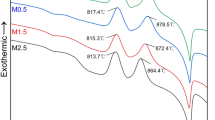Abstract
CaO–B2O3–SiO2 (CBS) glass–ceramics were used as the main research object in this study. Based on the predecessors’ work, we optimized the ternary components of glass–ceramics to observe its effects on the structure, sintering performance and dielectric properties of glass–ceramics. When the content of B2O3 was 15.5 mol%, the Ca/Si ratio was 0.61–0.62, the glass–ceramics were transparent after water quenching, and it could achieve sintering densification under 850 °C. When the Ca/Si ratio was < 0.61 and > 0.62, the state of glass–ceramics was changed from transparent to milk-whited. As for sintering, when the sintering temperature was above 900 °C, they could achieve sintering densification. On the basis of it, we fixed the Ca/Si ratio of 0.61, and adjusted the content of B2O3. We found that with the increasing of the B2O3 content, the transparency of glass–ceramics was worse and worse, and when the samples obtained the highest density, the sintering temperature were elevated from 820 to 920 °C. According to the XRD analysis, with the B2O3 content added, the CaB2O4 crystal phases in the glass–ceramics was increased, so the permittivity of the glass–ceramics was increased. When the Ca/Si ratio was 0.61 and the B2O3 content was 15.5 mol%, the sintered density of CBS glass–ceramics was 2.42 g/cm3 at 850 °C, the permittivity and dielectric loss was εr = 5.88, tanδ = 2.8 × 10−3 at 10 kHz.









Similar content being viewed by others
References
R.R. Tummala, J. Am. Ceram. Soc. 74, 895–908 (1991)
O. Dernovsek, A. Naeini, W.A. Schiller et al., J. Eur. Ceram. Soc. 21, 10 (2001)
C.C. Cheng, T.E. Hsieh, I.N. Lin, J. Eur. Ceram. Soc. 23, 2553–2558 (2003)
J. Chen, D. Yang, Z. Tong et al., J. Mater. Sci.: Mater. Electron. 27, 2 (2016)
M.T. Sebastian, H. Jantunen, Int. Mater. Rev. 53, 57–90 (2008)
B. Li, W. Li, J.G. Zheng, J. Alloys Compd. 725, 1091–1097 (2017)
Z.J. Qing, Mater. Lett. 212, 126–129 (2018)
J.H. Jean, Y.C. Fang, S.X. Dai, D.L. Wilcox, J. Am. Ceram. Soc. 84, 1354–1360 (2001)
C.L. Chen, W.C.J. Wei, A. Roosen, J. Eur. Ceram. Soc. 26, 59–65 (2006)
C.L. Lo, J.G. Duh, B.S. Chiou, W.H. Lee, J. Am. Ceram. Soc. 85, 2230–2235 (2002)
C.C. Chiang, S.F. Wang, Y.R. Wang, W.C.J. Wei, Ceram. Int. 34, 599–604 (2008)
S.H. Wang, H.P. Zhou, Mater. Sci. Eng. B 99, 597–600 (2003)
C.R. Chang, J.H. Jean, J. Am. Ceram. Soc. 82, 1725–1732 (1999)
X.F. Luo, L.C. Ren, H.Q. Zhou et al., J. Mater. Sci.: Mater. Electron. 27, 5446–5451 (2016)
X.H. Zhou, B. Li, S.R. Zhang et al., J. Mater. Sci.: Mater. Electron. 20, 262–266 (2009)
P.F. Wei, H.Q. Zhou et al., J. Cent. South Univ. Technol. 18, 1359–1364 (2011)
Y.S. Xia, Y.K. Hu, H.Q. Zhou et al., J. Eur. Ceram. Soc. 38, 253–261 (2018)
S. Rada, M. Culea, M. Neumann et al., Chem. Phys. Lett. 460, 196–199 (2008)
M.H. Kin, Y.H. Jeong, S. Nahm et al., J. Eur. Ceram. Soc. 26, 2139–2142 (2006)
Acknowledgements
This work was supported by the Priority Academic Program Development of Jiangsu Higher Education Institutions (PAPD), Jiangsu Collaborative Innovation Center for Advanced Inorganic Function Composites.
Author information
Authors and Affiliations
Corresponding author
Additional information
Publisher's Note
Springer Nature remains neutral with regard to jurisdictional claims in published maps and institutional affiliations.
Rights and permissions
About this article
Cite this article
Fu, Y., Li, P., Tao, H. et al. The effects of Ca/Si ratio and B2O3 content on the dielectric properties of the CaO–B2O3–SiO2 glass–ceramics. J Mater Sci: Mater Electron 30, 14053–14060 (2019). https://doi.org/10.1007/s10854-019-01770-7
Received:
Accepted:
Published:
Issue Date:
DOI: https://doi.org/10.1007/s10854-019-01770-7




